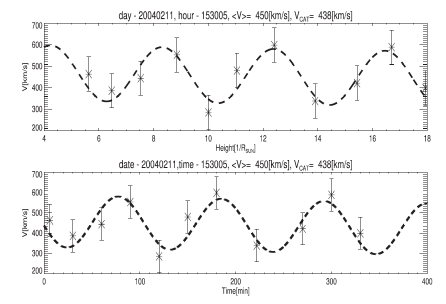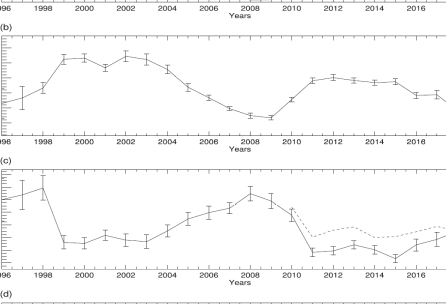Astronomy Object of the Month: 2023, March
< previous Archive next >
Periodic Oscillations in LASCO Coronal Mass Ejection Speeds: Space Seismology
Coronal mass ejections (CMEs) are energetic expulsions of organized magnetized plasma from the Sun. They are intensively studied because of their significant impact on Earth. The first CME was discovered in 1971 using the seventh Orbiting Solar Observatory (OSO-7). The longest series of observations have been carried out by the Large Angle and Spectrometric Coronagraph (LASCO) on board the Solar and Heliospheric Observatory (SOHO) mission.

Illustration 1:
Examples of fitted curves (dashed lines) to speed–distance/time profiles for CME on February 2011. The upper panel displays speed–distance profiles and the lower panel speed–time profile. We observe a clear speed oscillation with an amplitude of about 250 m s1.
Credit: The Authors.
Now we know that the magnetic field in CMEs and in the sheath ahead of shock-driving CMEs, especially the strength of the magnetic field component oriented in the direction opposite to that of Earth’s horizontal magnetic field (Bz), is crucial in causing geomagnetic storms along with the speed (V) with which the CME hits Earth’s magnetosphere. Unfortunately, routine measurements of magnetic fields, due to high temperature, in the outer solar atmosphere, where CMEs originate, are not available. To determine the magnetic field in the solar corona, we must apply indirect methods. It seems that one such method may be based on oscillations in the speed of CME. CMEs have an organized flux-rope magnetic structure. Therefore, the reconnection of the magnetic field during ejection may excite periodic speed oscillations. Periodic speed and intensity oscillations are well established in the case of quiescent prominences, which in many cases are progenitors of CMEs. These oscillations have a range of periodicity from a few minutes up to the order of an hour. We considered all the CMEs with at least 11 height–time measurements included in the CDAW database in the period of 1996–2019. It allowed us to evaluate speed–time profiles with enough accuracy to analyze oscillations in the speed of CMEs. Of the considered CMEs, 22% revealed periodic speed fluctuations during their expansion in the interplanetary medium. This means that speed oscillation is a frequent phenomenon associated with CME propagation.
We have obtained the following new important results. We demonstrated that the average values of the basic attributes of oscillations (amplitude and period) are significantly correlated with cycles of solar activity. In the maxima of solar activity, on average, pulsation periods are ≈240 minutes and in minima as much as ≈300 minutes. This means that periods of oscillations depend on the physical properties of ejections. It is assumed that the flux-rope structure inside CMEs can be approximated as a stretched elastic string of non-uniform density. Using this approximation, we estimated that, on average, the CME internal magnetic field varies from 18 up to 25 mG between the minimum and maximum of solar activity.

Illustration 2: Temporal evolution of average annual values of solar spot numbers (panel a), speed of CMEs revealing oscillations (panel b), periods of oscillations (panel c), and their amplitudes (panel d). Error bars show the standard deviation for a given sample. Dashed lines in panels (c) and (d) represent the results obtained with a reduced cadence of height–time points to match the SC 23 cadence.
Credit: The Authors.
The obtained results show that a detailed analysis of speed oscillations can be a very efficient tool for studying not only the physical properties of the ejections themselves but also the condition of the interplanetary medium in which they expand.
Original publication: G. Michałek et al., Periodic Oscillations in LASCO Coronal Mass Ejection Speeds: Space Seismology, AJL 927 (2022).
The research was conducted at the Department of High Energy Astrophysics of the Jagiellonian University’s Astronomical Observatory (OA UJ).
|
Grzegorz Michałek Astronomical Observatory Jagiellonian University G.Michalek [@] oa.uj.edu.pl |


